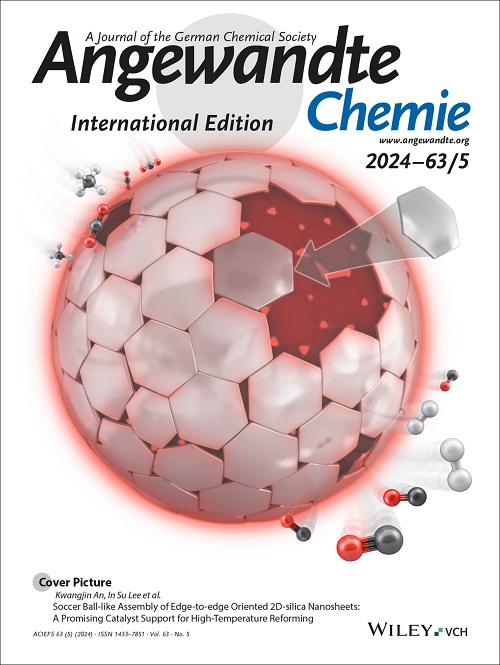Dual Active Sites with Charge-asymmetry in Organic Semiconductors Promoting C-C Coupling for Highly Efficient CO2 Photoreduction to Ethanol
IF 16.1
1区 化学
Q1 CHEMISTRY, MULTIDISCIPLINARY
引用次数: 0
Abstract
Selective CO2 photoreduction into high-energy-density and high-value-added C2 products is an ideal strategy to achieve carbon neutrality and energy shortage, but it is still highly challenging due to the large energy barrier of the C-C coupling step and severe exciton annihilation in photocatalysts. Herein, strong and localized charge polarization is successfully induced on the surface of melon-based organic semiconductors by creating dual active sites with a large charge asymmetry. Confirmed by multiscale characterization and theoretical simulations, such asymmetric charge distribution, originated from the oxygen dopants and nitrogen vacancies over melon-based organic semiconductors, reduces exciton binding energy and boosts exciton dissociation. The as-formed charge polarization sites not only donate electrons to CO2 molecules but also accelerate the coupling of asymmetric *CO*CO intermediates for CO2 photoreduction into ethanol by lowering the energy barrier of this process. Consequently, an exceptionally high selectivity of up to 97% for C2H5OH and C2H5OH yield of 0.80 mmol g-1 h-1 have been achieved on this dual active sites organic semiconductor. This work, with its potential applicability to a variety of non-metal multi-site catalysts, represents a versatile strategy for the development of advanced catalysts tailored for CO2 photoreduction reactions.有机半导体中电荷不对称的双活性位点促进 C-C 耦合,从而实现高效 CO2 光还原成乙醇
将二氧化碳选择性光还原为高能量密度和高附加值的 C2 产物是实现碳中和和能源短缺的理想策略,但由于 C-C 耦合步骤的能量势垒较大以及光催化剂中存在严重的激子湮灭现象,该策略仍具有很高的挑战性。在本文中,通过创建具有较大电荷不对称性的双活性位点,成功地在瓜基有机半导体表面诱导了强局部电荷极化。多尺度表征和理论模拟证实,这种不对称电荷分布源自瓜基有机半导体表面的氧掺杂剂和氮空位,可降低激子结合能并促进激子解离。所形成的电荷极化位点不仅能向二氧化碳分子提供电子,还能通过降低这一过程的能量势垒,加速不对称*CO*CO 中间产物的耦合,从而将二氧化碳光还原成乙醇。因此,在这种双活性位点有机半导体上实现了高达 97% 的 C2H5OH 选择性和 0.80 mmol g-1 h-1 的 C2H5OH 产率。这项研究成果可能适用于各种非金属多位点催化剂,是开发专门用于二氧化碳光还原反应的先进催化剂的通用策略。
本文章由计算机程序翻译,如有差异,请以英文原文为准。
求助全文
约1分钟内获得全文
求助全文
来源期刊
CiteScore
26.60
自引率
6.60%
发文量
3549
审稿时长
1.5 months
期刊介绍:
Angewandte Chemie, a journal of the German Chemical Society (GDCh), maintains a leading position among scholarly journals in general chemistry with an impressive Impact Factor of 16.6 (2022 Journal Citation Reports, Clarivate, 2023). Published weekly in a reader-friendly format, it features new articles almost every day. Established in 1887, Angewandte Chemie is a prominent chemistry journal, offering a dynamic blend of Review-type articles, Highlights, Communications, and Research Articles on a weekly basis, making it unique in the field.

 求助内容:
求助内容: 应助结果提醒方式:
应助结果提醒方式:


